The difference between Phosphorescence, Fluorescence and Bioluminescence

At PyroFarms when we say 'Grow the Glow' we are referring to natural bioluminescence.
Phosphorescence, bioluminescence, and fluorescence are all forms of luminescence, which is the emission of light without producing heat. However, the mechanisms that cause each of these phenomena are distinct, resulting in differences in their characteristics.
Bioluminescence

Bioluminescence is the biochemical emission of light by a living organism. This phenomenon is caused by a chemical reaction that occurs within specialized cells or organs, often involving the interaction between a molecule called luciferin and an enzyme called luciferase. Bioluminescence is found in a wide range of organisms, including bacteria, fungi, fish, and dinoflagellates (PyroDinos)
Our PyroDinos (dinoflagellates) are also referred to as 'microalgae' due to their plant-like properties.

PyroDinos absorb light during the day (converting light to chemical energy) and have the ability to produce natural light at night via a biochemical reaction. This naturally produced light is bioluminescence.
PyroDino bioluminescence only occurs at night. As the night progresses the bioluminescent potential increases. Thus you will see more bioluminescence later in the night as the PyroDinos will have more time to make the components for the 'light producing' biochemical reaction.
Fluorescence
Fluorescence is a type of luminescence that occurs when a material absorbs light energy and immediately emits it back at a longer wavelength. This means that the emitted light has a different color than the absorbed light. Fluorescent materials contain molecules called fluorophores, which absorb light at specific wavelengths and then emit light at longer wavelengths. Fluorescence is commonly used in scientific research, such as in fluorescence microscopy, where fluorescent dyes are used to label and visualize specific structures within cells.
The FluoroSphere is based on Fluorescence. The FluoroSphere uses a USB powered light base which supplies the activating light. The light base emission is blue and difficult to see in a dark room. The FluoroSphere is filled with water and placed on the light base. Green FluoroGel (which is red in color) is added to the FluoroSphere. As the 'red' FluoroGel dissolves into the water it becomes fluorescent and emits yellow-green light.

The light from the light base is absorbed and released as a different color (yellow).
Phosphorescence

Phosphorescence is the emission of light in a similar manner to fluorescence but on a longer timescale, so that emission continues after excitation ceases. The emission of light is delayed, sometimes up to several hours, after the initial exposure to light. Phosphorescent materials store the absorbed energy in excited electronic states that can persist for a long time. This process is known as phosphorescent decay.
The photo shown below is an example of bioluminescence (from a Dino-Tile) emanating from the lower right corner of the Dino-Tile. The glowing sphere is displaying phosphorescence. The Sphere is emitting light it absorbed earlier in the day.

Places to see bioluminescence in nature: Marine Bioluminescence in Nature
Buy PyroDinos HERE



Comments